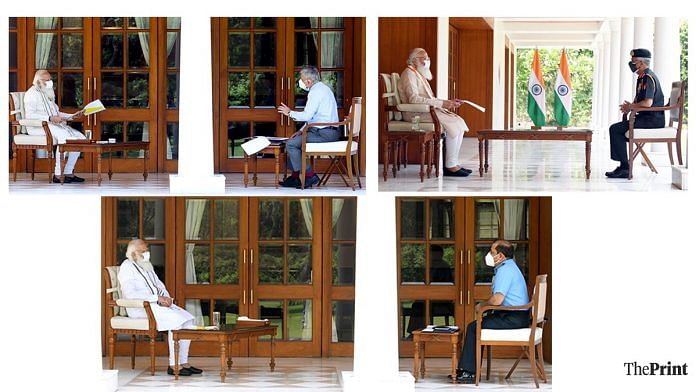Masked up and socially distanced, PM Modi met Army chief General M.M. Naravane, IAF chief R.K.S. Bhadauria & CDS General Bipin Rawat to take stock of Covid readiness.

Clockwise) PM Narendra Modi meets CDS General Bipin Rawat, Chief of Army Staff General MM Naravane and Air Chief Marshal RKS Bhadauria, in New Delhi this week | ANIText Size: A- A+
New Delhi: Despite a massive surge in Covid-19 cases, Prime Minister Narendra Modi has been meeting India’s top defence officials — but all meetings have been outdoors, following all the safety protocols.
This comes amid recent studies claiming that small and micron-scale aerosol droplets are primarily responsible for the spread of Covid-19, especially indoors.
PM Modi Thursday met Chief of Army Staff General M.M. Naravane to discuss the Army’s initiatives to help in Covid-19 management. Sitting across a table at the PM’s residence at Lok Kalyan Marg in New Delhi, both Modi and Naravane were wearing masks and maintaining adequate distance.
On Wednesday, the PM held a meeting with Air Chief Marshal R.K.S. Bhadauria to take stock of the efforts of the Indian Air Force to deal with the Covid situation. Bhadauria and Modi were seen sitting across two separate tables
In another meeting Monday, PM Modi met CDS General Bipin Rawat at his residence.
PM Modi’s in-person meetings come at a time when there has been a massive spike in cases with India’s Covid tally reaching 3.79 lakh cases and more than 3,600 deaths in the last 24 hours.
Many top policymakers and officials in the central government are also out of action after getting infected by the virus. Over two dozen secretaries, additional secretaries and joint secretaries across central government ministries, including the health ministry, have tested positive for the coronavirus in April.
Also read: PSA oxygen plants — the cleaner, cheaper tech that could help ease India’s current crisis
What science says
An MIT study, published in the journal Proceedings of the National Academy of Sciences of the United States of America recently, pointed out that there is now overwhelming evidence that relatively small, micron-scale aerosol droplets are primarily responsible for the spread of Covid-19, especially indoors.
Airborne transmission arises through the inhalation of aerosol droplets exhaled by an infected person and is thought to be the primary transmission route of Covid-19. The respiratory droplets are mixed uniformly through an indoor and unventilated space, thus increasing the chance of infection.
The study noted that small infected drops may accumulate and remain suspended by the ambient airflow and mixed throughout the room, until they are removed by the ventilation outflow or inhaled.https://296978b1916d211c005312eff18a0dea.safeframe.googlesyndication.com/safeframe/1-0-38/html/container.html
In that case, staying outdoors while wearing masks and maintaining social distancing can relatively lessen the spread of Covid-19.
In the study of 7,324 early cases outside the Hubei Province in China, the authors found that all clusters of three or more cases occurred indoors, with 80 per cent arising inside apartment homes and 34 per cent potentially involving public transportation. Only a single transmission was recorded outdoors.
Finally, the fact that face mask directives have been more effective than either lockdowns or social distancing in controlling the spread of Covid-19 is consistent with indoor airborne transmission as the primary driver of the pandemic.
(Edited by Debalina Dey)
Also read: More people died of Covid in Delhi in last 4 days than in Mumbai since March
